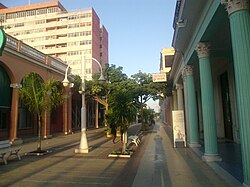|
Ciego de Ávila
Ciego de Ávila (Spanish pronunciation: [ˈsjeɣo ðe ˈaβila]) is a city in the central part of Cuba and the capital of Ciego de Ávila Province. The capital city has a population of about 156,322 and the province 430,507.[3] GeographyCiego de Ávila lies on the Carretera Central highway and on a major railroad. Its port, Júcaro, lies 24 km (15 mi) south-southwest on the coast of the Gulf of Ana Maria of the Caribbean Sea, in the adjacent municipality of Venezuela. The city is located about 460 km (290 mi) east of Havana and 110 km (68 mi) west of the city of Camagüey. It was part of the Camagüey Province until 1976, when Fidel Castro's government made Ciego de Ávila the capital of the newly created Ciego de Ávila Province. By 1945, the municipality was divided into the barrios of Angel Castillo, Ceballos, Guanales, Jagüeyal, Jicotea, José Miguel Gómez, Júcaro, La Ceiba, Majagua, Norte, San Nicolás and Sur. After the new political and administrative division of Cuba in 1976, it was divided into four municipalities (Majagua, Ciego de Ávila, Baragua, and Venezuela).[1] ClimateCiego de Ávila experiences a tropical savanna climate (Köppen Aw).
History The city of Ciego de Ávila was founded by 1840, having at the time 263 inhabitants. In 1877, its municipal government was created and the city became independent of the city of Morón. Ciego de Ávila gained importance when the Spanish army built a fortified military line, known as Trocha de Júcaro a Morón, to impede the pass of insurrectionist forces to the western part of the island during the 1st War of Independence (1868–1878). This "trocha", which made this region famous, was thought to be strong enough to stop the Cuban forces, but was not able to stop the pass of General Máximo Gómez and several hundred men. Many of the old Spanish colonial buildings in Ciego de Ávila (such as the Teatro Principal) were commissioned under Angela Hernández, viuda de Jiménez, a rich socialite who battled to create a cultural mecca in her hometown. DemographicsIn 2022, the Municipality of Ciego de Ávila had a population of 156,322.[3] With a total area of 445 km2 (172 sq mi),[2] it has a population density of 350/km2 (910/sq mi). Attractions
MediaIts present radio station, Radio Surco (previously Radio Cuba), was founded October 10, 1952. SportsCiego de Ávila's basketball team has been one of the most successful teams in the country, as it has won 9 national championships since 2005. Notable residents
See alsoReferences
External linksWikimedia Commons has media related to Ciego de Ávila. |
||||||||||||||||||||||||||||||||||||||||||||||||||||||||||||||||||||||||||||||||||||||||||||||||||||||||||||||||||||||||||||||||||||
Portal di Ensiklopedia Dunia


